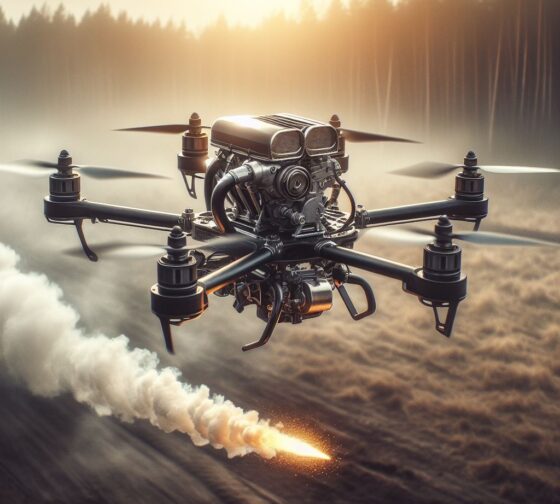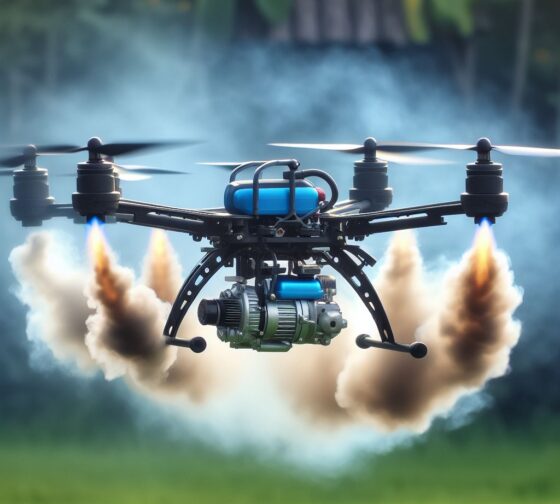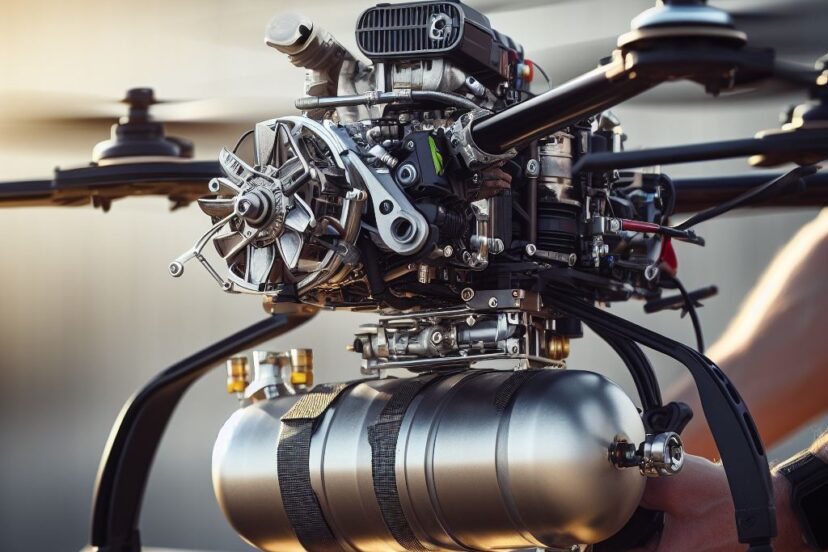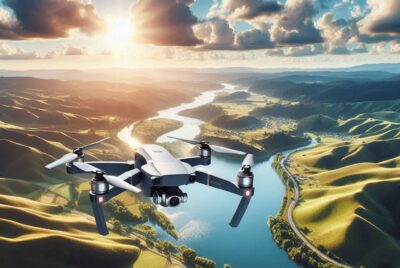Gas Powered Drone: Revolutionizing Aerial Technology
*We may earn a commission for purchases made using our links. Please see our disclosure to learn more.
Gas Powered Drone Advantages: Unleashing Aerial Power and Endurance
In recent years, the advent and popularity of electric drones have soared due to their wide range of applications, from recreational uses to vital roles in surveillance and delivery services. However, a niche yet significant development in this evolving technology is the emergence of the gas powered drone. These drones distinguish themselves by their endurance and capability to fly farther and longer than their electric counterparts, offering a robust alternative for scenarios demanding extended flight times and heavier payloads.
My assessment of gas powered drones reveals that they are equipped with internal combustion engines that provide a distinct advantage in terms of range and efficiency. This makes them especially suitable for tasks that require continuous, uninterrupted flight, such as search and rescue missions or extensive aerial surveys. While electric drones are constrained by battery life and charging times, gas powered drones can simply refuel, effectively minimizing downtime and enhancing productivity in the field.
Overview of Gas Powered Drones

In discussing gas powered drones, it’s vital to understand their distinctions from electric models, the advantages they offer in terms of performance, and the key models currently making an impact in the market.
Gas Vs. Electric Drones
Gas powered drones operate using internal combustion engines, typically running on gasoline or a gasoline-oil mix. In comparison, electric drones are powered by rechargeable battery packs. While electric drones deliver the convenience of easy recharging and reduced noise, gas-powered drones provide longer flight times and can carry heavier payloads. For instance, the DJI S1000+ Pro is designed to carry substantial equipment for professional videography.
Advantages of Gas Powered Drones
The primary advantages of gas-powered drones stem from their powerful engines. These drones offer extended flight times and can operate efficiently in scenarios where battery life may be restrictive. Models like the Incredible HLQ and YEair, which are equipped with gasoline engines, exemplify the capability to lift heavy loads over longer distances. With two-stroke engines, these drones enhance operational range and endurance, making them ideal for tasks requiring sustained airborne presence.
Key Gas-Powered Drone Models
Several gas-powered drone models have made a mark in the market:
- DJI Matrice 600 Pro: This model boasts a hefty payload capacity and can fly at speeds reaching 40 mph, with a maximum flight time of 35 minutes, depending on payload weight.
- Nitro Stingray: Featuring a two-stroke Scorpion motor and 110mm blades, this drone uses a sophisticated flight controller for precise piloting.
- YEair Quadcopter: Though specifics are not always publicly available, its twin gasoline engine setup hints at a powerful performance.
- Incredible HLQ: As a heavy-lift quadcopter, this model stands out for its lifting capabilities, powered by robust gas engines.
These drones illustrate a cross-section of the power and versatility available in the realm of gas-powered unmanned aerial vehicles.
Technical Specifications
In this section, I will provide detailed information about the power systems, flight endurance, and carrying capabilities of gas-powered drones, aspects crucial for understanding their operational potential.
Engine and Power Details
Gas-powered drones typically utilize either two-stroke or four-stroke internal combustion engines. The horsepower tends to vary, with models like those in conceptual stages promising significant power output. My knowledge indicates that a two-stroke engine delivers power every two cycles of the piston, which often provides a higher power-to-weight ratio favoring drones where weight is at a premium.
- Power Source: Gasoline
- Common Engine Type: Two-stroke engine
- Horsepower: Varies, but high relative to drone size
Flight Time and Fuel Efficiency
One of the main benefits of gas-powered drones over their battery-powered counterparts is extended flight time. A sizeable fuel tank and efficient fuel system mean these drones can often stay airborne for periods ranging from 30 minutes to several hours, much longer than typical battery-powered drones. Fuel consumption will, of course, depend on various factors including engine efficiency, drone weight, and operational conditions.
- Flight Time: Up to several hours
- Fuel Efficiency: Dependent on model and operational use
- Fuel Type: Gasoline
Payload Capacity Considerations
When it comes to payload capacity, gas-powered drones like the DJI Matrice 600 Pro can carry significant weight. The maximum payloads that these drones are capable of lifting generally align with their increased flight time and fuel capacity, thus offering considerable utility for different professional applications. The capacity to lift and transport equipment or sensors is a critical specification, as this determines the drone’s practical applications.
- Payload Capacity: Up to 5.5 pounds or more
- Influence on Flight Time: Weight reduces flight endurance
- Relevance: Crucial for professional applications involving heavy lifting or specialized sensors
Design and Build Features

In designing gas-powered drones, my primary focus remains on aerodynamics for stability, weight efficiency through careful material selection, and offering a range of customization options which cater to diverse applications.
Aerodynamics and Stability
Gas-powered drones require refined aerodynamics to ensure stability and ease of control during flight. I often equip drones with sophisticated synapse controllers for real-time adjustments, which maintain balance despite variable conditions. Furthermore, the design incorporates variable pitch propellers which allow for precise maneuvering, a functionality that is essential in models like the DJI Mavic Pro. By designing the chassis to channel airflow efficiently, I can significantly improve both lift and stability.
Materials and Weight Considerations
The materials chosen have a critical impact on performance, with a priority given to lightweight components without compromising durability. In my designs, carbon fiber is a favored material because of its high strength-to-weight ratio. This material contributes to the portability of designs like the DJI S1000+, while also ensuring the drone can handle the stresses of flight. The intricacies of the build also consider the weight added by combustion engines, often a V-twin lawnmower engine, necessitating a careful balance to maintain optimal performance.
Customization and Build Options
Customization is key to adapting drones to specific use-case requirements. My design process involves configuring the drone to accommodate various build specifics, like extended fuel tanks or specialized payload attachments. For example, drones tailored for agricultural use may feature a modular design to swap out pesticide dispensers or imaging equipment rapidly. The ability to modify and upgrade elements like the propellers or engines empowers users to fine-tune their drones for their particular needs.
Practical Uses

In the realm of gas powered drones, the practical applications are diverse and influential, extending across various sectors from commercial to emergency services. These drones are making a notable impact due to their extended flight times and enhanced lifting capabilities.
Commercial and Industrial Applications
My investigations reveal that gas-powered drones are reshaping how tasks are approached in the commercial and industrial spheres. The reason is their ability to carry heavier payloads compared to their electric counterparts. This heavy lifting capability is instrumental for tasks such as industrial inspections and transporting materials over large facilities. Gas-powered drones offer a reliable solution for these applications due to their:
- Prolonged endurance, ensuring they can cover vast industrial areas without the frequent need for recharging.
- Robustness in various weather conditions, allowing consistent operation when electric drones might fail.
Aerial Photography and Filmmaking
When it comes to aerial photography and filmmaking, gas-powered drones stand out for their performance. I’ve observed that filmmakers often opt for these UAVs (Unmanned Aerial Vehicles) because they can fly for longer periods and support the weight of professional-grade cameras and equipment. Here’s how they make a difference:
- Extended flight time: Crucial for capturing extensive footage without interruptions.
- Stability and lifting: Essential for high-quality imagery, allowing for the use of advanced camera systems.
Search and Rescue Operations
In the critical arena of search and rescue missions, every second counts, and gas-powered drones have proven themselves as valuable assets. Their capability to stay airborne for hours significantly exceeds that of traditional electric drones, making them ideal for sustained operations. My experience with these UAVs shows that they offer:
- Faster deployment and greater coverage area, aiding in locating individuals swiftly.
- The robustness required to operate in challenging conditions where conventional crewed helicopters or electric drones might not be feasible.
By employing gas-powered drones with commercial helicopter rotor heads, rescue teams gain the agility and efficiency needed to improve the outcomes of their missions.
Regulations and Safety

In this section, I will discuss the essential aspects of safely operating a gas-powered drone while adhering to the regulatory framework. Understanding these factors is crucial for any pilot who wants to navigate the skies without incident.
Safety Measures
Safety is paramount when flying gas-powered drones. I always ensure that my drone is in good working order before takeoff, checking for any mechanical issues that could present risks during flight. It’s also important to maintain a safe distance from people, property, and other aircraft. For emergencies, I keep a communication plan ready, which includes notifying local authorities if an incident occurs.
Regulatory Considerations
Navigating the drone regulations can be daunting. It’s critical to be aware that different countries have their own rules. In the United States, for example, gas-powered drones are subject to regulations by the Federal Aviation Administration (FAA). I stay updated on these guidelines and ensure my drone complies with the Remote ID rule, which mandates certain drones to broadcast identification and location information.
Pilot Requirements
To operate a gas-powered drone legally, I needed to obtain a drone license from the FAA. This involves passing an aeronautical knowledge test to receive a Remote Pilot Certificate. It’s my responsibility to renew this certification every 24 months. To help fellow pilots, I’ve listed some frequently asked questions (FAQs) that give further insight into drone licensure:
- Do I need a license for every drone I fly? A pilot certificate allows you to operate multiple drones, provided they are all compliant with the applicable regulations.
- What are the age requirements for obtaining a drone license? You must be at least 16 years old to sit for the FAA aeronautical knowledge test.
By adhering to these safety measures, regulatory considerations, and pilot requirements, I can ensure a safe and legally compliant flight experience.
Frequently Asked Questions
In this section, I address some of the most common inquiries regarding gas-powered drones, providing concise and informative answers to help you understand their costs, capabilities, and uses.
1. What is the typical price range for gas-powered drones?
The pricing for gas-powered drones is quite variable, with entry-level models starting from a few hundred dollars, while specialized or industrial-grade drones can soar into several thousand dollars.
2. How long is the flight time for gas-powered drones?
Gas-powered drones typically offer extended flight times compared to their battery-powered counterparts, often capable of staying airborne for several hours depending on their design and fuel capacity.
3. Can gas-powered drones be equipped with cameras?
Yes, gas-powered drones can be equipped with cameras, and often are, to serve purposes ranging from aerial photography to advanced surveillance and data collection.
4. What are the best gas-powered drones available on the market?
While the “best” can be subjective based on use-case, some popular gas-powered drones are praised for their power and endurance, with options available from both established industry leaders and specialized manufacturers.
5. What is the average range of a gas-powered drone used in agriculture?
The range of gas-powered drones in agriculture can vary widely, but on average, they can cover distances of several miles, allowing for efficient monitoring and management of large farming operations.




